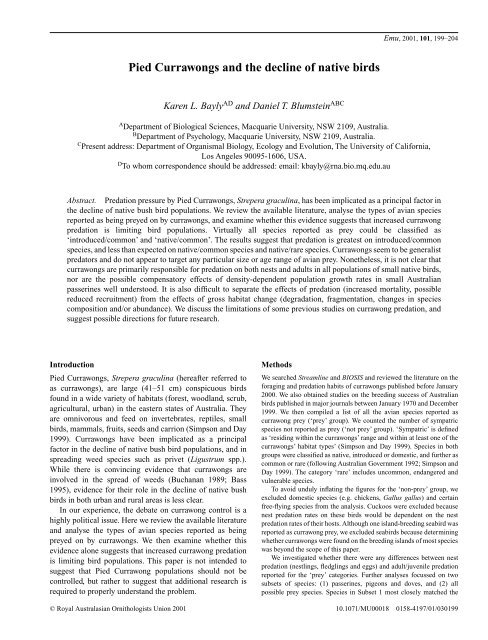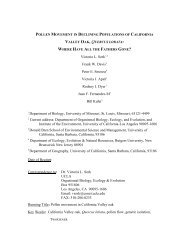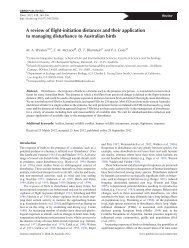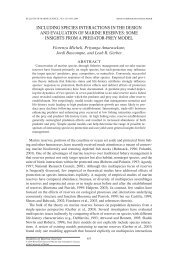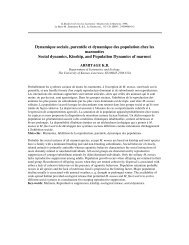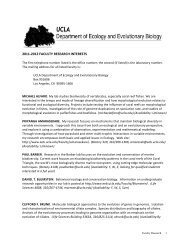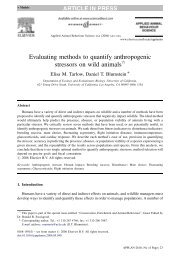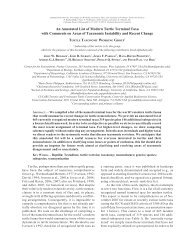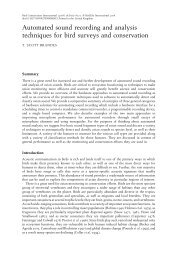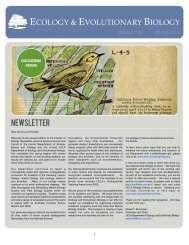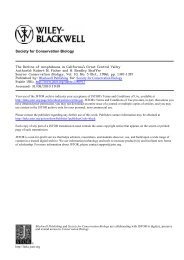Pied Currawongs and the decline of native birds - UCLA Department ...
Pied Currawongs and the decline of native birds - UCLA Department ...
Pied Currawongs and the decline of native birds - UCLA Department ...
Create successful ePaper yourself
Turn your PDF publications into a flip-book with our unique Google optimized e-Paper software.
Emu, 2001, 101, 199–204<br />
<strong>Pied</strong> <strong>Currawongs</strong> <strong>and</strong> <strong>the</strong> <strong>decline</strong> <strong>of</strong> <strong>native</strong> <strong>birds</strong><br />
Karen L. Bayly AD <strong>and</strong> Daniel T. Blumstein ABC<br />
A <strong>Department</strong> <strong>of</strong> Biological Sciences, Macquarie University, NSW 2109, Australia.<br />
B <strong>Department</strong> <strong>of</strong> Psychology, Macquarie University, NSW 2109, Australia.<br />
C Present address: <strong>Department</strong> <strong>of</strong> Organismal Biology, Ecology <strong>and</strong> Evolution, The University <strong>of</strong> California,<br />
Los Angeles 90095-1606, USA.<br />
D To whom correspondence should be addressed: email: kbayly@rna.bio.mq.edu.au<br />
Abstract. Predation pressure by <strong>Pied</strong> <strong>Currawongs</strong>, Strepera graculina, has been implicated as a principal factor in<br />
<strong>the</strong> <strong>decline</strong> <strong>of</strong> <strong>native</strong> bush bird populations. We review <strong>the</strong> available literature, analyse <strong>the</strong> types <strong>of</strong> avian species<br />
reported as being preyed on by currawongs, <strong>and</strong> examine whe<strong>the</strong>r this evidence suggests that increased currawong<br />
predation is limiting bird populations. Virtually all species reported as prey could be classified as<br />
‘introduced/common’ <strong>and</strong> ‘<strong>native</strong>/common’. The results suggest that predation is greatest on introduced/common<br />
species, <strong>and</strong> less than expected on <strong>native</strong>/common species <strong>and</strong> <strong>native</strong>/rare species. <strong>Currawongs</strong> seem to be generalist<br />
predators <strong>and</strong> do not appear to target any particular size or age range <strong>of</strong> avian prey. None<strong>the</strong>less, it is not clear that<br />
currawongs are primarily responsible for predation on both nests <strong>and</strong> adults in all populations <strong>of</strong> small <strong>native</strong> <strong>birds</strong>,<br />
nor are <strong>the</strong> possible compensatory effects <strong>of</strong> density-dependent population growth rates in small Australian<br />
passerines well understood. It is also difficult to separate <strong>the</strong> effects <strong>of</strong> predation (increased mortality, possible<br />
reduced recruitment) from <strong>the</strong> effects <strong>of</strong> gross habitat change (degradation, fragmentation, changes in species<br />
composition <strong>and</strong>/or abundance). We discuss <strong>the</strong> limitations <strong>of</strong> some previous studies on currawong predation, <strong>and</strong><br />
suggest possible directions for future research.<br />
Introduction<br />
<strong>Pied</strong> <strong>Currawongs</strong>, Strepera graculina (hereafter referred to<br />
as currawongs), are large (41–51 cm) conspicuous <strong>birds</strong><br />
found in a wide variety <strong>of</strong> habitats (forest, woodl<strong>and</strong>, scrub,<br />
agricultural, urban) in <strong>the</strong> eastern states <strong>of</strong> Australia. They<br />
are omnivorous <strong>and</strong> feed on invertebrates, reptiles, small<br />
<strong>birds</strong>, mammals, fruits, seeds <strong>and</strong> carrion (Simpson <strong>and</strong> Day<br />
1999). <strong>Currawongs</strong> have been implicated as a principal<br />
factor in <strong>the</strong> <strong>decline</strong> <strong>of</strong> <strong>native</strong> bush bird populations, <strong>and</strong> in<br />
spreading weed species such as privet (Ligustrum spp.).<br />
While <strong>the</strong>re is convincing evidence that currawongs are<br />
involved in <strong>the</strong> spread <strong>of</strong> weeds (Buchanan 1989; Bass<br />
1995), evidence for <strong>the</strong>ir role in <strong>the</strong> <strong>decline</strong> <strong>of</strong> <strong>native</strong> bush<br />
<strong>birds</strong> in both urban <strong>and</strong> rural areas is less clear.<br />
In our experience, <strong>the</strong> debate on currawong control is a<br />
highly political issue. Here we review <strong>the</strong> available literature<br />
<strong>and</strong> analyse <strong>the</strong> types <strong>of</strong> avian species reported as being<br />
preyed on by currawongs. We <strong>the</strong>n examine whe<strong>the</strong>r this<br />
evidence alone suggests that increased currawong predation<br />
is limiting bird populations. This paper is not intended to<br />
suggest that <strong>Pied</strong> Currawong populations should not be<br />
controlled, but ra<strong>the</strong>r to suggest that additional research is<br />
required to properly underst<strong>and</strong> <strong>the</strong> problem.<br />
Methods<br />
We searched Streamline <strong>and</strong> BIOSIS <strong>and</strong> reviewed <strong>the</strong> literature on <strong>the</strong><br />
foraging <strong>and</strong> predation habits <strong>of</strong> currawongs published before January<br />
2000. We also obtained studies on <strong>the</strong> breeding success <strong>of</strong> Australian<br />
<strong>birds</strong> published in major journals between January 1970 <strong>and</strong> December<br />
1999. We <strong>the</strong>n compiled a list <strong>of</strong> all <strong>the</strong> avian species reported as<br />
currawong prey (‘prey’ group). We counted <strong>the</strong> number <strong>of</strong> sympatric<br />
species not reported as prey (‘not prey’ group). ‘Sympatric’ is defined<br />
as ‘residing within <strong>the</strong> currawongs’ range <strong>and</strong> within at least one <strong>of</strong> <strong>the</strong><br />
currawongs’ habitat types’ (Simpson <strong>and</strong> Day 1999). Species in both<br />
groups were classified as <strong>native</strong>, introduced or domestic, <strong>and</strong> fur<strong>the</strong>r as<br />
common or rare (following Australian Government 1992; Simpson <strong>and</strong><br />
Day 1999). The category ‘rare’ includes uncommon, endangered <strong>and</strong><br />
vulnerable species.<br />
To avoid unduly inflating <strong>the</strong> figures for <strong>the</strong> ‘non-prey’ group, we<br />
excluded domestic species (e.g. chickens, Gallus gallus) <strong>and</strong> certain<br />
free-flying species from <strong>the</strong> analysis. Cuckoos were excluded because<br />
nest predation rates on <strong>the</strong>se <strong>birds</strong> would be dependent on <strong>the</strong> nest<br />
predation rates <strong>of</strong> <strong>the</strong>ir hosts. Although one isl<strong>and</strong>-breeding seabird was<br />
reported as currawong prey, we excluded sea<strong>birds</strong> because determining<br />
whe<strong>the</strong>r currawongs were found on <strong>the</strong> breeding isl<strong>and</strong>s <strong>of</strong> most species<br />
was beyond <strong>the</strong> scope <strong>of</strong> this paper.<br />
We investigated whe<strong>the</strong>r <strong>the</strong>re were any differences between nest<br />
predation (nestlings, fledglings <strong>and</strong> eggs) <strong>and</strong> adult/juvenile predation<br />
reported for <strong>the</strong> ‘prey’ categories. Fur<strong>the</strong>r analyses focussed on two<br />
subsets <strong>of</strong> species: (1) passerines, pigeons <strong>and</strong> doves, <strong>and</strong> (2) all<br />
possible prey species. Species in Subset 1 most closely matched <strong>the</strong><br />
© Royal Australasian Ornithologists Union 2001 10.1071/MU00018 0158-4197/01/030199
200 Karen L. Bayly <strong>and</strong> Daniel T. Blumstein<br />
genera in <strong>the</strong> ‘prey’ group whereas Subset 2 contains some genera that<br />
have never been reported as currawong prey.<br />
We used contingency table analysis to gain some insight into<br />
observed patterns <strong>of</strong> predation. Residual analysis determines where,<br />
<strong>and</strong> in what direction, <strong>the</strong> observed data deviates from <strong>the</strong> expected<br />
values (Haberman 1978).<br />
For <strong>the</strong> ‘prey’ group, we also noted each species’ preferred habitat<br />
<strong>and</strong> adult size (average length from bill tip along back to tail tip).<br />
Finally, we examined <strong>the</strong> evidence for a clear causal relationship<br />
between <strong>the</strong> presence <strong>of</strong> currawongs <strong>and</strong> a <strong>decline</strong> in populations <strong>of</strong><br />
small <strong>birds</strong>.<br />
Results<br />
Of <strong>the</strong> species listed in <strong>the</strong> literature (Table 1), <strong>the</strong> only avian<br />
species that had been clearly identified as being significantly<br />
limited by currawong predation was an endangered<br />
isl<strong>and</strong>-nesting seabird (Priddel <strong>and</strong> Carlile 1995); this was<br />
not included in <strong>the</strong> statistical analysis. Reports by o<strong>the</strong>r<br />
authors on <strong>birds</strong> taken by currawongs are mostly anecdotal<br />
<strong>and</strong> consist <strong>of</strong> ei<strong>the</strong>r unspecified numbers <strong>of</strong> predation events<br />
or a single observation. In many cases, it is typically unclear<br />
whe<strong>the</strong>r currawongs killed <strong>the</strong> species listed or merely<br />
scavenged <strong>the</strong> remains (e.g. Cooper <strong>and</strong> Cooper 1981;<br />
Prawiradilaga 1994; Wood 1998).<br />
Virtually all species reported as prey were classified as<br />
‘introduced/common’ <strong>and</strong> ‘<strong>native</strong>/common’ (Table 2). Most<br />
(62%) <strong>native</strong>/common <strong>and</strong> introduced/common species<br />
recorded were found in urban environments. <strong>Currawongs</strong><br />
preyed on free-flying <strong>birds</strong> as well as on nests (Table 3).<br />
For <strong>the</strong> most conservatively matched subset <strong>of</strong> species<br />
(passerines <strong>and</strong> doves), predation was greater on introduced/<br />
common species <strong>and</strong> less on <strong>native</strong>/rare species than<br />
expected (Table 2). This is based on <strong>the</strong> null hypo<strong>the</strong>sis <strong>of</strong> no<br />
difference between observed <strong>and</strong> expected frequencies <strong>of</strong><br />
predation for <strong>the</strong>se categories. There are no reports <strong>of</strong> predation<br />
in ei<strong>the</strong>r <strong>of</strong> <strong>the</strong> ‘rare’ categories, possibly because <strong>the</strong><br />
probabilities <strong>of</strong> observing <strong>the</strong>se events are extremely low.<br />
We also compared <strong>the</strong> frequencies <strong>of</strong> predation for pairs<br />
<strong>of</strong> categories using contingency table analysis. Predation on<br />
introduced/common <strong>and</strong> <strong>native</strong>/common species differed<br />
more than expected (Fisher’s Exact P = 0.003). Introduced/<br />
common species were preyed on more than expected<br />
(adjusted residual 3.3), while <strong>native</strong>/common species were<br />
preyed on less <strong>the</strong>n expected (adjusted residual –3.3).<br />
Similar results were found with Subset 2 (Fisher’s Exact<br />
P = 0.001).<br />
Adult <strong>and</strong> juvenile prey were 8–45 cm in length (mean<br />
21.5 cm), with 40.7% <strong>of</strong> prey species larger than 21.5 cm.<br />
Discussion<br />
<strong>Currawongs</strong> appear to be generalist avian predators <strong>and</strong> do<br />
not appear to target any particular size or age range <strong>of</strong> avian<br />
prey. Although <strong>the</strong>y prey on similar numbers <strong>of</strong> nests <strong>and</strong><br />
adults in both <strong>the</strong> <strong>native</strong>/common <strong>and</strong> introduced/common<br />
categories, predation pressure appears to be greater on<br />
introduced/common species than <strong>native</strong>/common species.<br />
This may result from a bias toward fewer introduced species<br />
occurring in greater abundance in areas where many<br />
observers live, or greater susceptibility to currawong<br />
predation in introduced <strong>birds</strong>.<br />
‘Common’ species may still be in <strong>decline</strong> (Recher 1999),<br />
<strong>and</strong> given currawongs’ predatory abilities, it is possible that<br />
<strong>the</strong>y may have some deleterious effects on populations <strong>of</strong><br />
small <strong>birds</strong> in certain areas. Ford et al. (2001) have published<br />
a comprehensive review <strong>of</strong> <strong>the</strong> reasons why small <strong>birds</strong> have<br />
<strong>decline</strong>d in rural areas <strong>of</strong> sou<strong>the</strong>rn Australia, <strong>and</strong> suggest a<br />
number <strong>of</strong> hypo<strong>the</strong>ses to guide fur<strong>the</strong>r research. Below, we<br />
discuss <strong>the</strong> limitations <strong>of</strong> some previous studies on<br />
currawong predation, <strong>and</strong> suggest possible directions for<br />
future research.<br />
Are currawongs primarily responsible for predation on both<br />
nests <strong>and</strong> adults?<br />
Small <strong>birds</strong> <strong>and</strong> <strong>the</strong>ir nests are preyed upon by a range <strong>of</strong><br />
avian (see Major et al. 1996) <strong>and</strong> non-avian predators (e.g.<br />
reptiles: Prawiradilaga 1996; Green <strong>and</strong> Cockburn 1999;<br />
Zanette <strong>and</strong> Jenkins 2000). Most reports <strong>of</strong> predation, <strong>and</strong><br />
notably currawong predation, on adult <strong>birds</strong> are anecdotal.<br />
Determining which predator preyed on a nest is usually<br />
based on how <strong>of</strong>ten a predator species is observed in <strong>the</strong><br />
study area (natural nests), <strong>and</strong> on beak or claw imprints in<br />
dummy eggs (artificial nests). The use <strong>of</strong> artificial nests in<br />
nest predation studies can overestimate <strong>the</strong> rate <strong>of</strong> predation<br />
or <strong>the</strong> relative importance <strong>of</strong> different predators (Taylor <strong>and</strong><br />
Ford 1998).<br />
For example, a substantial recent study on nest predation<br />
recruited members <strong>of</strong> <strong>the</strong> public to collect data through a<br />
multi-media advertising campaign (Major et al. 1996). Large<br />
<strong>birds</strong> were identified as <strong>the</strong> predominant predators, based on<br />
<strong>the</strong> number <strong>of</strong> large beak imprints on dummy eggs (48.5% <strong>of</strong><br />
total predation), but it was not possible to ascertain which<br />
species made each imprint. In a very small number <strong>of</strong> opportunistically<br />
observed cases (for 11.8% <strong>of</strong> all preyed-upon<br />
nests), currawongs were seen to prey on about half <strong>the</strong> nests<br />
(6.1% <strong>of</strong> all preyed-upon nests). This trend was assumed to<br />
underlie all <strong>the</strong> data <strong>and</strong> currawongs were subsequently<br />
identified as <strong>the</strong> dominant nest predator.<br />
While <strong>the</strong> study <strong>of</strong> Major et al.(1996) clearly identified<br />
<strong>birds</strong> as important nest predators in urban areas, <strong>the</strong> identification<br />
<strong>of</strong> currawongs as <strong>the</strong> dominant nest predator is not<br />
convincing. We suggest that systematic observational studies<br />
are needed to identify nest predators conclusively.<br />
In areas where currawong populations have increased, has<br />
overall nest predation pressure also increased to <strong>the</strong> extent<br />
that it significantly affects recruitment?<br />
Figures for nesting failure in Australian <strong>birds</strong> show enormous<br />
variability among species (39–92.2%, n = 22 species:<br />
Robinson 1990) <strong>and</strong> within species in <strong>the</strong> same locality (e.g.
<strong>Pied</strong> <strong>Currawongs</strong> <strong>and</strong> <strong>the</strong> <strong>decline</strong> <strong>of</strong> <strong>native</strong> <strong>birds</strong> 201<br />
Table 1. Age range, abundance <strong>and</strong> habitat type <strong>of</strong> <strong>native</strong>, introduced <strong>and</strong> domestic prey species reported taken by <strong>Pied</strong> <strong>Currawongs</strong><br />
Age range categories: E = egg, NF = nestling/fledgling, J = juvenile, A = adult, JA = juvenile or adult. Abundance categories: A = abundant,<br />
LA = locally abundant, C = common, MC = moderately common, LC = locally common, LUC = locally uncommon, R = rare (after Simpson <strong>and</strong><br />
Day 1999). Habitat-type categories: Ur = urban, human habitation, gardens, parkl<strong>and</strong>; Ag = agricultural, farml<strong>and</strong>, orchard; Ru = rural, country;<br />
Fo = forest, woodl<strong>and</strong>; Du = prefers availability <strong>of</strong> dense undergrowth, In = inl<strong>and</strong>; Si = sea <strong>and</strong> isl<strong>and</strong>, He = heath (after Flegg <strong>and</strong> Madge 1995;<br />
Simpson <strong>and</strong> Day 1999). References: 1 = Allison (1993); 2 = Ashby (1927); 3 = Bell (1985); 4 = Bridges (1994); 5 = Butterfield (1988); 6 = Chittick<br />
(1990); 7 = Cooper <strong>and</strong> Cooper (1981); 8 = Crowe (1978); 9 = Emery (1988); 10 = Ford (1999); 11 = Hoskin et al. (1991); 12 = Hunt <strong>and</strong> Hunt<br />
(1995); 13 = Lenz (1990); 14 = Lepschi (1993); 15 = Manuel (1992); 16 = McFarl<strong>and</strong> (1978); 17 = Metcalf (1988); 18 = Miller <strong>and</strong> Naisbitt (1994);<br />
19 = Morris <strong>and</strong> Burton (1994); 20 = Portbury (1992); 21 = Prawiradilaga (1994); 22 = Prawiradilaga (1996); 23 = Priddel <strong>and</strong> Carlile (1995);<br />
24 = Recher <strong>and</strong> Schulz (1983); 25 = Roberts (1942); 26 = Robinson (1990); 27 = S. G. Pruett-Jones in Langmore <strong>and</strong> Mulder (1992); 28 = S. Debus<br />
in Cooper <strong>and</strong> Cooper (1981); 29 = Sefton (1988); 30 = Taylor (1986); 31 = Tibicen (1978); 32 = Vellenga (1980); 33 = Vestjens <strong>and</strong> Vestjens (1970);<br />
34 = Wood (1998); 35 = Wood (1995); 36 = Wood (1997), 37 = W. Roll<strong>and</strong> in Miller <strong>and</strong> Naisbitt (1994)<br />
Category Common name Scientific name Age range Abundance Habitat type References<br />
Native, common Australian Magpie Gymnorhina tibicen NF, J C–LA Ur, Ag, Fo 1, 7, 8<br />
Black-faced Cuckoo Shrike Coracina novaeholl<strong>and</strong>iae E, NF MC–C Ur, Fo 15, 29<br />
Brown Thornbill Acanthiza pusilla JA LUC–C Fo, Du 17<br />
Flame Robin Petroica phoenicia NF C Ur, Ag, Fo, 26<br />
Du<br />
Jacky Winter Microeca fascinans NF LC–MC Ag 11<br />
Little (Brush) Wattlebird Anthochaera chrysoptera NF C Ur, Fo, He 29<br />
Magpie Lark Grallina cyanoleuca NF C Ur, Ag, In 29<br />
New Holl<strong>and</strong> Honeyeater Phylidonyris novaeholl<strong>and</strong>iae NF C Fo, He 16<br />
Noisy Friarbird Philemon corniculatus NF C–LA Fo 10<br />
Pardalote Pardalotus spp. JA MC–C Fo 20<br />
Red Wattlebird Anthochaera carunculata NF, A C Ur, Fo 7, 19, 20, 21<br />
Red-browed Finch Neochmia temporalis NF C Ur, Fo, Du 1<br />
Rufous Whistler Pachycephala rufiventris NF C Fo 4<br />
Silvereye Zosterops lateralis NF, JA C Ur, Ag 1, 14, 17, 28<br />
Spotted Pardalote Pardalotus punctatus J MC–C Fo 35<br />
Superb Fairy-wren Malurus splendens E, NF, JA C Ur, Fo, Du 21, 22, 27<br />
Thornbill Acanthiza spp. E, NF, JA C Fo 3, 20<br />
Welcome Swallow Hirundo neoxena JA C Ur, Ag, Fo, In 6<br />
White-bellied Cuckoo-shrike Coracina papuensis E MC–C Fo 12<br />
White-browed Scrub-wren Sericornis frontalis E, NF, JA C Ur, He, Du 22<br />
White-browed Woodswallow Artamus superciliosis E MC– LA In 24<br />
White-naped Honeyeater Melithreptus lunatus A C Fo 32<br />
White-winged Chough Corcorax melanorhampos NF C Fo 21<br />
Willie Wagtail Rhipidura leucophrys NF C–A Ur, Ag, Fo, In 29<br />
Yellow-faced Honeyeater Lichenostomus chrysops A C Fo 32<br />
Yellow-rumped Thornbill Acanthiza chrysorrhoa NF C Ur, Fo, Ag 1<br />
Native, rare Gould's Petrel Pterodroma leucoptera JA R Si 23<br />
Introduced, common Common Blackbird Turdus merula E, NF, J, A LC–C Ur, Ru 1, 6, 8, 17, 20,<br />
21, 31, 32, 33<br />
Common Myna Acrido<strong>the</strong>res tristis NF, JA C–LA Ur 1, 28<br />
Common Starling Sturnus vulgaris E, NF, J, A C–A Ur, Ru 1, 5, 8, 13, 17,<br />
21, 30, 32<br />
European Goldfinch Carduelis carduelis J LC Ag 31<br />
House Sparrow Passer domesticus E, NF, J, A C Ur, Ag 1, 8, 13, 14, 17,<br />
28, 30, 32<br />
Red-whiskered Bulbul Pycnonotus jocosus NF LC–C Ur 9, 29, 34<br />
Spotted Turtle-dove Sreptopelia senegalensis E, A, JA A Ur, Ag 7, 18, 20, 36<br />
Domestic Budgerigar Melopsitticus undulatus A LC Ur 37<br />
Canary Serinius canarius A UC Ur 28<br />
Chicken Gallus gallus E, J LC Ur, Ag 2, 25<br />
Turkey Meleagris gallopavo J LC Ur, Ag 25
202 Karen L. Bayly <strong>and</strong> Daniel T. Blumstein<br />
Table 2.<br />
Passerine <strong>and</strong> dove prey <strong>of</strong> <strong>Pied</strong> <strong>Currawongs</strong><br />
χ 2 = 17.74, P = 0.001<br />
Prey<br />
Not prey<br />
Native / common 26 92<br />
Native / rare A 0 16<br />
Introduced / common B 7 3<br />
Introduced / rare 0 1<br />
A Adjusted residual = –2.3<br />
B Adjusted residual = 3.7<br />
Table 3.<br />
Types <strong>of</strong> predation by <strong>Pied</strong> <strong>Currawongs</strong><br />
χ 2 = 0.396, P = 0.651<br />
No. <strong>of</strong> reports for<br />
Native / common Introduced / common<br />
Nest predation 27 23<br />
Adult / juvenile predation 15 17<br />
45.8–70.0% for Regent Honeyeaters, Xanthomyza phrygia:<br />
Geering <strong>and</strong> French 1998), in different localities (e.g.<br />
52–84% for Brown Thornbills, Acanthia pusilla: Bell 1985;<br />
Green <strong>and</strong> Cockburn 1999) <strong>and</strong> between years (e.g. 58–89%<br />
for White-browed Scrubwrens, Sericornis frontalis:<br />
Prawiradilaga 1996). The most important cause <strong>of</strong> nest<br />
failure is high predation (around 50–60% <strong>of</strong> all nests), but as<br />
most studies have been carried out in fragmented habitats it<br />
is difficult to know whe<strong>the</strong>r <strong>the</strong>se predation rates are truly<br />
characteristic <strong>of</strong> Australian <strong>birds</strong> (Ford et al. 2001).<br />
However, <strong>the</strong>re is some evidence that Australian <strong>birds</strong>’<br />
breeding biology has been shaped by high rates <strong>of</strong> predation<br />
(Robinson 1990; Rowley <strong>and</strong> Russell 1991), <strong>and</strong> <strong>the</strong> mean<br />
success rates <strong>of</strong> nests does not differ between those studies<br />
carried out in fragmented habitat <strong>and</strong> those in continuous<br />
habitat (Ford et al. 2001).<br />
While <strong>the</strong>re have been a number <strong>of</strong> important studies on<br />
nest predation by currawongs (Wood 1995, 1998;<br />
Prawiradilaga 1996), <strong>the</strong>se studies have failed to show any<br />
population <strong>decline</strong> in <strong>the</strong> prey species. Predation on eggs <strong>and</strong><br />
chicks is less likely to affect subsequent breeding numbers<br />
than predation on adults because <strong>of</strong> greater opportunities for<br />
improved recruitment <strong>of</strong> surviving young into <strong>the</strong> breeding<br />
population (Newton 1998). Therefore, high nest predation<br />
rates may not be detrimental to long-term population<br />
viability if overall rates are within an historically normal<br />
range. We suggest that, to fully underst<strong>and</strong> <strong>the</strong> effects <strong>of</strong> nest<br />
predation on limiting populations, studies must document<br />
later density-dependent population growth rates <strong>and</strong> determine<br />
whe<strong>the</strong>r <strong>the</strong>se are compensatory.<br />
Are <strong>the</strong>re factors o<strong>the</strong>r than predation contributing to bush<br />
bird <strong>decline</strong>?<br />
Clearing <strong>of</strong> <strong>native</strong> vegetation, grazing pressure, inappropriate<br />
fire regimes, over-abundance <strong>of</strong> certain feral <strong>and</strong><br />
<strong>native</strong> animals, water quality <strong>and</strong> flow, <strong>and</strong> lack <strong>of</strong> appropriate<br />
reserve systems are known to contribute to <strong>decline</strong> in<br />
Australian wildlife (Recher 1999).<br />
Human-induced habitat change tends to favour large or<br />
aggressive <strong>birds</strong> over small <strong>native</strong> insectivorous <strong>birds</strong><br />
(Recher 1972) <strong>and</strong> over-abundance <strong>of</strong> species is a poorly<br />
acknowledged result <strong>of</strong> habitat change (Recher 1999). For<br />
example, Noisy Miners, Manorina melanocephala, are <strong>of</strong>ten<br />
found in great abundance in altered or degraded habitats<br />
(Ford et al. 2001) <strong>and</strong> are extremely effective in excluding<br />
o<strong>the</strong>r bird species (Dow 1977; Loyn 1985). Recent experimental<br />
reduction <strong>of</strong> Noisy Miner numbers in woodl<strong>and</strong> remnants<br />
in Victoria resulted in increased populations <strong>of</strong> small<br />
<strong>native</strong> <strong>birds</strong> (Grey et al. 1997, 1998).<br />
Many <strong>native</strong> bush <strong>birds</strong> require substantial understorey<br />
(Green <strong>and</strong> Catterall 1998) or forest remnants (Sewell <strong>and</strong><br />
Catterall 1998) to thrive. Ironically, introduced weeds such<br />
as lantana can provide this type <strong>of</strong> shelter in developed areas.<br />
Removal <strong>of</strong> <strong>the</strong>se plants in some areas may have unwittingly<br />
left bush bird populations vulnerable to both predation <strong>and</strong><br />
aggressive encounters with competitors.<br />
We suggest that factors o<strong>the</strong>r than predation should also<br />
be seriously considered when designing experiments to<br />
ascertain <strong>the</strong> cause <strong>of</strong> bush bird <strong>decline</strong>. For example,<br />
removal <strong>of</strong> currawongs in areas denuded <strong>of</strong> habitat suitable<br />
for small <strong>birds</strong> is unlikely to result in recolonisation <strong>of</strong> <strong>the</strong><br />
area by small <strong>birds</strong>, but may be appropriate where suitable<br />
habitat still exists.<br />
Are currawongs controlling populations <strong>of</strong> introduced<br />
species?<br />
Populations <strong>of</strong> introduced species such as House Sparrows,<br />
Passer domesticus, Common Starlings, Sturnus vulgaris, <strong>and</strong><br />
Common Mynas, Acrido<strong>the</strong>res tristus, have doubled over <strong>the</strong><br />
past 50 years (Blakers et al. 1984) <strong>and</strong> appear to be targeted<br />
by currawongs in urban areas (Taylor 1986; Metcalf 1988;<br />
Lenz 1990). It is possible that currawongs exert some control<br />
over <strong>the</strong>se populations, both by competing for food (Bass<br />
1995) <strong>and</strong> by predation on adults <strong>and</strong> nests. Although<br />
sparrows <strong>and</strong> mynas are cavity nesters, <strong>the</strong>re are reports <strong>of</strong><br />
nest predation on <strong>the</strong>se species (Table 1). The published data<br />
that we have collated suggests strongly that <strong>the</strong>re is significant<br />
predation pressure on introduced species, although this<br />
needs to be confirmed by more detailed studies. <strong>Currawongs</strong><br />
may be an important predator <strong>of</strong> <strong>the</strong>se species in urban areas,<br />
<strong>and</strong> control measures may be counterproductive in <strong>the</strong>se<br />
localities.<br />
Is controlling currawong populations an effective method for<br />
dealing with currawong predation on sensitive species?<br />
Controlling currawong populations proved successful in protecting<br />
Gould’s Petrel, Pterodroma leucoptera (Priddel <strong>and</strong><br />
Carlile 1995). On <strong>the</strong> mainl<strong>and</strong>, similar control programs<br />
may be effective in increasing bird populations at small
<strong>Pied</strong> <strong>Currawongs</strong> <strong>and</strong> <strong>the</strong> <strong>decline</strong> <strong>of</strong> <strong>native</strong> <strong>birds</strong> 203<br />
scales (Grey et al. 1998), or protecting endangered or<br />
vulnerable species, <strong>and</strong> currawong-removal programs may<br />
prove to be necessary conservation measures in such cases.<br />
However, control measures are a short-term solution<br />
(Newton 1998). Population control by poisoning is likely to<br />
select for behavioural modification (Garnett 1998; Temby<br />
1998) or genetically resistant individuals (e.g. Warfarin<br />
resistance in rats), <strong>and</strong> may affect non-target species (Garnett<br />
1998). In addition, <strong>the</strong>re are no currently approved avicides<br />
in Australia, <strong>and</strong> shooting is ineffective for large numbers <strong>of</strong><br />
<strong>birds</strong> (Garnett 1998). Finally, killing <strong>birds</strong> may not have<br />
much impact on population size <strong>and</strong> populations may easily<br />
recover (Feare 1991), or simply move elsewhere, transferring<br />
<strong>the</strong> problem to ano<strong>the</strong>r site (Bosch et al. 2000). For<br />
long-term control, altered habitats must be made less suitable<br />
for currawongs, <strong>and</strong> more suitable for small bush <strong>birds</strong><br />
(Ford et al. 2001).<br />
Conclusion<br />
An objective examination <strong>of</strong> <strong>the</strong> evidence suggests that <strong>the</strong><br />
<strong>decline</strong> in bush <strong>birds</strong> is <strong>the</strong> result <strong>of</strong> an interaction between<br />
many factors, ra<strong>the</strong>r than <strong>the</strong> result <strong>of</strong> currawong predation<br />
alone. Never<strong>the</strong>less, this does not preclude <strong>the</strong> possibility<br />
that predation pressure by currawongs is <strong>the</strong> primary cause<br />
<strong>of</strong> bush bird <strong>decline</strong> in some areas. Scientifically based<br />
policy can only be made on <strong>the</strong> available data, <strong>and</strong> we<br />
strongly support <strong>the</strong> call for more detailed studies. We<br />
suggest that population-reduction measures should be <strong>the</strong><br />
outcome <strong>of</strong> carefully controlled, peer-reviewed experimental<br />
<strong>and</strong> observational evidence, ra<strong>the</strong>r than based on anecdote or<br />
emotion. Assessing <strong>the</strong> effectiveness <strong>and</strong> viability <strong>of</strong> currawong<br />
control will require well designed currawong-removal<br />
experiments, <strong>and</strong> population monitoring in a variety <strong>of</strong><br />
habitats. However, following Ford et al. (2001) <strong>and</strong> Recher<br />
(1999), we caution that reversing <strong>the</strong> <strong>decline</strong> <strong>of</strong> <strong>native</strong> bush<br />
<strong>birds</strong> will be achieved sustainably only through substantial<br />
habitat restoration.<br />
Acknowledgments<br />
We thank Alan Taylor for invaluable advice on <strong>the</strong> statistical<br />
analysis, <strong>and</strong> Chris Evans, Hugh Ford, Rob Harcourt,<br />
Ian McLean, <strong>and</strong> Harry Recher for constructive comments<br />
on a previous version.<br />
References<br />
Allison, B. (1993). From petfood to persimmons: BOCA survey <strong>of</strong> <strong>Pied</strong><br />
Currawong food, autumn/winter 1992. The Bird Observer 727,<br />
10–14.<br />
Ashby, E. (1927). The Grampian Range <strong>of</strong> Victoria <strong>and</strong> its bird life.<br />
Emu 27, 285–292.<br />
Australian Government (1992). ‘Endangered Species Act 1992.<br />
Schedule 1.’ (AGPS: Canberra.)<br />
Bass, D. A. (1995). Contribution <strong>of</strong> introduced fruits to <strong>the</strong> winter diet<br />
<strong>of</strong> <strong>Pied</strong> <strong>Currawongs</strong> in Armidale, New South Wales. Corella 19,<br />
127–132.<br />
Bell, H. L. (1985). The social organisation <strong>and</strong> foraging behaviour <strong>of</strong><br />
three syntopic thornbills Acanthiza spp. In ‘Birds <strong>of</strong> Eucalypt<br />
Forests <strong>and</strong> Woodl<strong>and</strong>s: Ecology, Conservation <strong>and</strong> Management’.<br />
(Eds A. Keast, H. F. Recher, H. A. Ford <strong>and</strong> D. A. Saunders.)<br />
pp. 151–163. (Surrey Beatty: Sydney.)<br />
Blakers, M., Davis, S. J. J. F., <strong>and</strong> Reilly, P. N. (1984). ‘The Atlas <strong>of</strong><br />
Australian Birds.’ (RAOU & Melbourne University Press:<br />
Melbourne.)<br />
Bosch, M., Oro, D., Cantos, F. J., <strong>and</strong> Zabala, M. (2000). Short-term<br />
effects <strong>of</strong> culling on <strong>the</strong> ecology <strong>and</strong> population dynamics <strong>of</strong> <strong>the</strong><br />
yellow-legged gull. Journal <strong>of</strong> Applied Ecology 37, 369–385.<br />
Bridges, L. (1994). Breeding biology <strong>of</strong> a migratory population <strong>of</strong> <strong>the</strong><br />
Rufous Whistler (Pachycephala rufiventris). Emu 94, 106–115.<br />
Buchanan, R. A. (1989). <strong>Pied</strong> <strong>Currawongs</strong> (Strepera graculina): <strong>the</strong>ir<br />
diet <strong>and</strong> role in weed dispersal in suburban Sydney, New South<br />
Wales. Proceedings <strong>of</strong> <strong>the</strong> Linnean Society <strong>of</strong> New South Wales 111,<br />
241–255.<br />
Butterfield, M. A. (1988). Predation <strong>of</strong> small <strong>birds</strong> by non-raptors.<br />
Canberra Bird Notes 13, 34.<br />
Chittick, S. C. (1990). <strong>Pied</strong> <strong>Currawongs</strong> taking food on <strong>the</strong> wing.<br />
Canberra Bird Notes 15, 13.<br />
Cooper, C., <strong>and</strong> Cooper, R. (1981). Observations on <strong>the</strong> food sources<br />
utilised by <strong>Pied</strong> <strong>Currawongs</strong>. Australian Birds 15, 50–52.<br />
Crowe, I. (1978). <strong>Pied</strong> <strong>Currawongs</strong> at Berrima. Canberra Bird Notes 4,<br />
12.<br />
Dow, D. D. (1977). Indiscriminate interspecific aggression leading to<br />
almost sole occupancy <strong>of</strong> space by a single species <strong>of</strong> bird. Emu 77,<br />
115–121.<br />
Emery, W. (1988). <strong>Currawongs</strong> versus bul buls – third time lucky.<br />
Illawarra Bird Observers Club Newsletter 115, 4.<br />
Feare, C. J. (1991). Control <strong>of</strong> pest bird populations. In ‘Bird Population<br />
Studies: Relevance to Conservation <strong>and</strong> Management’. (Eds C. M.<br />
Perrin, J. D. Lebreton <strong>and</strong> G. J. M. Hirons.) pp. 463–496. (Oxford<br />
University Press: Oxford.)<br />
Flegg, J., <strong>and</strong> Madge, S. (1995). ‘Reader’s Digest Photographic Field<br />
Guide to <strong>the</strong> Birds <strong>of</strong> Australia.’ (Reader’s Digest: Surry Hills.)<br />
Ford, H. A. (1999). Nest sites <strong>and</strong> breeding success in large Australian<br />
honeyeaters: are <strong>the</strong>re benefits from being different? Emu 99,<br />
91–99.<br />
Ford, H. A., Barrett, G. W., Saunders, D. A., <strong>and</strong> Recher, H. F. (2001).<br />
Why have <strong>birds</strong> in <strong>the</strong> woodl<strong>and</strong>s <strong>of</strong> sou<strong>the</strong>rn Australia <strong>decline</strong>d?<br />
Biological Conservation 97, 71–88.<br />
Garnett, S. (1998). Red-tailed Black-cockatoo damage <strong>and</strong> damage<br />
mitigation at Lakel<strong>and</strong> Downs, Cape York Peninsula. Eclectus 5,<br />
26–34.<br />
Geering, D., <strong>and</strong> French, K. (1998). Breeding biology <strong>of</strong> <strong>the</strong> Regent<br />
Honeyeater Xanthomyza phrygia in <strong>the</strong> Capertee Valley, New South<br />
Wales. Emu 98, 104–116.<br />
Green, D. J., <strong>and</strong> Cockburn, A. (1999). Life history <strong>and</strong> demography <strong>of</strong><br />
an uncooperative Australian passerine, <strong>the</strong> brown thornbill.<br />
Australian Journal <strong>of</strong> Zoology 47, 633–649.<br />
Green, R. J., <strong>and</strong> Catterall, C. P. (1998). The effects <strong>of</strong> forest clearing<br />
<strong>and</strong> regeneration on <strong>the</strong> fauna <strong>of</strong> Wivenhoe Park, south-east<br />
Queensl<strong>and</strong>. Wildlife Research 25, 677–690.<br />
Grey, M. J., Clarke, M. F., <strong>and</strong> Loyn, R. H. (1997). Initial changes in <strong>the</strong><br />
avian communities <strong>of</strong> remnant eucalypt woodl<strong>and</strong>s following a<br />
reduction in <strong>the</strong> abundance <strong>of</strong> Noisy Miners, Manorina<br />
melanocephala. Wildlife Research 24, 631–618.<br />
Grey, M. J., Clarke, M. F., <strong>and</strong> Loyn, R. H. (1998). Influence <strong>of</strong> <strong>the</strong><br />
Noisy Miner Manorina melanocephala on avian diversity <strong>and</strong><br />
abundance in remnant Grey Box woodl<strong>and</strong>. Pacific Conservation<br />
Biology 4, 55–69.<br />
Haberman, S. J. (1978). ‘Analysis <strong>of</strong> Qualitative Data.’ (Academic<br />
Press: New York.)
204 Karen L. Bayly <strong>and</strong> Daniel T. Blumstein<br />
Hoskin, E. S., Hindwood, K. A., <strong>and</strong> McGill, A. R. (1991). ‘The Birds<br />
<strong>of</strong> Sydney, County <strong>of</strong> Cumberl<strong>and</strong>.’ (Surrey Beatty: Sydney.)<br />
Hunt, J., <strong>and</strong> Hunt, S. (1995). Good guys <strong>and</strong> bad guys. NSW Bird<br />
Atlassers Newsletter 45, 2–3.<br />
Langmore, N. E., <strong>and</strong> Mulder, R. A. (1992). A novel context for bird<br />
song: predator calls prompt male singing in <strong>the</strong> kleptogamous<br />
Superb Fairy-wren, Malurus cyaneus. Ethology 90, 143–153.<br />
Lenz, M. (1990). The <strong>Pied</strong> Currawong in urban Canberra: friend or foe?<br />
Canberra Bird Notes 15, 2–9.<br />
Lepschi, B. J. (1993). Food <strong>of</strong> some <strong>birds</strong> in eastern New South Wales:<br />
additions to Barker & Vestjens. Emu 93, 195–199.<br />
Loyn, R. H. (1985). Birds in fragmented forests in Gippsl<strong>and</strong>, Victoria.<br />
In ‘Birds <strong>of</strong> Eucalypt Forests <strong>and</strong> Woodl<strong>and</strong>s: Ecology,<br />
Conservation <strong>and</strong> Management’. (Eds A. Keast, H. F. Recher,<br />
H. A. Ford <strong>and</strong> D. A. Saunders.) pp. 323–331. (Surrey Beatty:<br />
Sydney.)<br />
Major, R. E., Gowing, G., <strong>and</strong> Kendal, C. E. (1996). Nest predation in<br />
Australian urban environments <strong>and</strong> <strong>the</strong> role <strong>of</strong> <strong>the</strong> pied currawong,<br />
Strepera graculina. Australian Journal <strong>of</strong> Ecology 21, 399–409.<br />
Manuel, B. (1992). Predation by <strong>Pied</strong> <strong>Currawongs</strong>. New South Wales<br />
Field Ornithologists Club Newsletter 129, 8.<br />
McFarl<strong>and</strong>, D. C. (1978). Breeding behaviour <strong>of</strong> <strong>the</strong> New Holl<strong>and</strong><br />
Honeyeater Phylidonyris novaeholl<strong>and</strong>iae. Emu 86, 161–167.<br />
Metcalf, R. A. (1988). Observations on aviphagy by <strong>Pied</strong> <strong>Currawongs</strong>.<br />
Canberra Bird Notes 13, 32–33.<br />
Miller, M. A., <strong>and</strong> Naisbitt, R. (1994). A technique employed by a <strong>Pied</strong><br />
Currawong Strepera graculina to capture a Spotted Turtle-dove<br />
Streptopelia chinensis. Australian Bird Watcher 15, 320–321.<br />
Morris, A. K., <strong>and</strong> Burton, A. (1994). New South Wales Annual Bird<br />
Report 1992. Australian Birds 27, 97–139.<br />
Newton, I. (1998). ‘Population Limitation in Birds.’ (Academic Press:<br />
San Diego.)<br />
Portbury, M. (1992). <strong>Pied</strong> <strong>Currawongs</strong> – friend or foe? Bird Observer<br />
723, 3.<br />
Prawiradilaga, D. M. (1994). Caching behaviour <strong>of</strong> breeding <strong>Pied</strong><br />
<strong>Currawongs</strong>. Australian Bird Watcher 15, 275–276.<br />
Prawiradilaga, D. M. (1996). Foraging ecology <strong>of</strong> <strong>Pied</strong> <strong>Currawongs</strong><br />
Strepera graculina in recently colonised areas <strong>of</strong> <strong>the</strong>ir region. Ph.D.<br />
Thesis, Australian National University, Canberra.<br />
Priddel, D., <strong>and</strong> Carlile, N. (1995). Mortality <strong>of</strong> adult Gould’s Petrels<br />
Pterodroma leucoptera leucoptera at <strong>the</strong> nesting site on Cabbage<br />
Tree Isl<strong>and</strong>, New South Wales. Emu 95, 259–264.<br />
Recher, H. F. (1972). The vertebrate fauna <strong>of</strong> Sydney. Proceedings <strong>of</strong><br />
<strong>the</strong> Ecological Society <strong>of</strong> Australia 7, 79–87.<br />
Recher, H. F. (1999). The state <strong>of</strong> Australia’s avifauna: a personal<br />
opinion <strong>and</strong> prediction for <strong>the</strong> new millennium. Australian<br />
Zoologist 31, 11–27.<br />
Recher, H. F., <strong>and</strong> Schulz, M. (1983). Observations on <strong>the</strong> breeding <strong>of</strong><br />
White-browed Woodswallows. Corella 7, 1–6.<br />
Roberts, N. L. (1942). The winter flocking <strong>of</strong> <strong>the</strong> <strong>Pied</strong> Currawong. Emu<br />
42, 17–24.<br />
Robinson, D. (1990). The nesting ecology <strong>of</strong> sympatric Scarlet Robin<br />
Petroica multicolour <strong>and</strong> Flame Robin P. phoenicea in open<br />
eucalypt forest. Emu 90, 40–52.<br />
Rowley, I., <strong>and</strong> Russell, E. (1991). Demography <strong>of</strong> Passerines in <strong>the</strong><br />
temperate Sou<strong>the</strong>rn Hemisphere. In ‘Bird Population Studies:<br />
Relevance to Conservation <strong>and</strong> Management’. (Eds C. M. Perrin,<br />
J. D. Lebreton <strong>and</strong> G. J. M. Hirons.) pp. 22–44. (Oxford University<br />
Press: Oxford.)<br />
Sefton, A. (1988). <strong>Pied</strong> currawong: notorious nest robber. Illawarra<br />
Bird Observers Club Newsletter 113, 4.<br />
Sewell, S. R., <strong>and</strong> Catterall, C. P. (1998). Bushl<strong>and</strong> modification <strong>and</strong><br />
styles <strong>of</strong> urban development: <strong>the</strong>ir effects on <strong>birds</strong> in south-east<br />
Queensl<strong>and</strong>. Wildlife Research 25, 41–63.<br />
Simpson, K., <strong>and</strong> Day, N. (1999). ‘Field Guide to <strong>the</strong> Birds <strong>of</strong><br />
Australia.’ (Viking Penguin: Melbourne.)<br />
Taylor, I. M. (1986). <strong>Pied</strong> Currawong predation on introduced <strong>birds</strong>.<br />
Canberra Bird Notes 11, 132–133.<br />
Taylor, L. N. H., <strong>and</strong> Ford, H. A. (1998). Predation <strong>of</strong> artificial nests in<br />
a fragmented l<strong>and</strong>scape on <strong>the</strong> New Engl<strong>and</strong> tablel<strong>and</strong>s <strong>of</strong> New<br />
South Wales. Wildlife Research 25, 587–594.<br />
Temby, I. (1998). Reducing cockatoo damage in Victoria. Eclectus 5,<br />
20–22.<br />
Tibicen, G. (1978). Out <strong>and</strong> about. Canberra Bird Notes 4, 26–27.<br />
Vellenga, R. (1980). <strong>Pied</strong> Currawong b<strong>and</strong>ing observations. Australian<br />
Bird Watcher 8, 243–246.<br />
Vestjens, W., <strong>and</strong> Vestjens, C. (1970). Birds in a Canberra garden.<br />
Canberra Bird Notes 1, 10–13.<br />
Wood, K. A. (1995). Is <strong>the</strong> <strong>Pied</strong> Currawong a bird <strong>of</strong> prey? Canberra<br />
Bird Notes 20, 34–36.<br />
Wood, K. A. (1997). Predation by <strong>the</strong> <strong>Pied</strong> Currawong at a nest <strong>of</strong> <strong>the</strong><br />
Spotted Turtle-dove. Australian Birds 30, 45–48.<br />
Wood, K. A. (1998). Seasonal changes in diet <strong>of</strong> <strong>Pied</strong> <strong>Currawongs</strong><br />
Strepera graculina at Wollongong, New South Wales. Emu 98,<br />
157–170.<br />
Zanette, L., <strong>and</strong> Jenkins, B. (2000). Nesting success <strong>and</strong> nest predators<br />
in forest fragments: a study using real <strong>and</strong> artificial nests. Auk 117,<br />
445–454.<br />
Manuscript received 19 April 2000; accepted 29 November 2000<br />
http://www.publish.csiro.au/journals/emu


